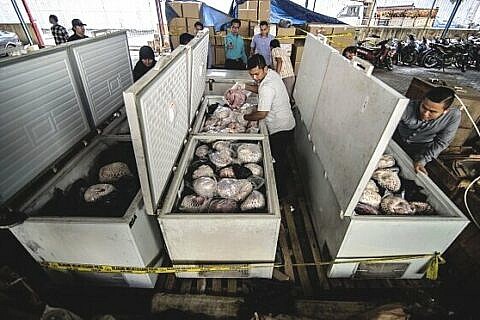Intercepted in Motion
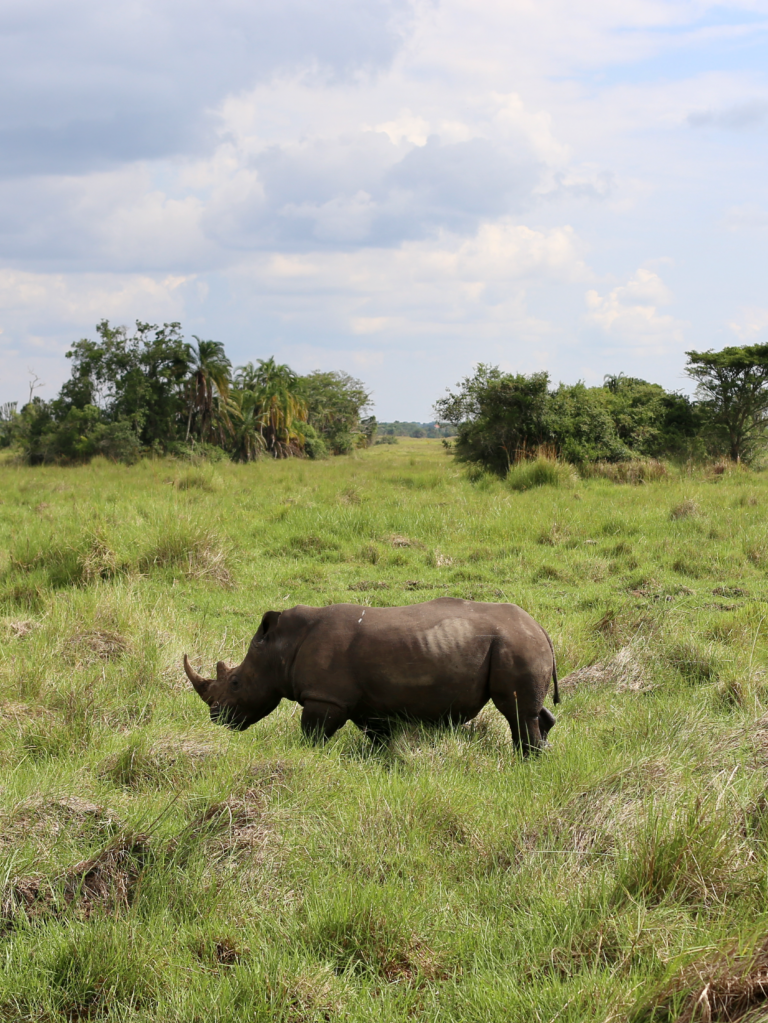
In this update to our 2024 Intercepted issue brief, we analyze 386 global ivory, rhino horn, and pangolin product seizures that occurred in the 16 months following our last investigation — finding that while total seizure counts have declined, many of the same trafficking typologies remain highly active and are continuing to evolve in 2025.
Para ler este relatório em português, clique aqui.
The data used for this analysis is from the C4ADS Wildlife Seizure Database, which brings together publicly reported data on seizures of wildlife products. Seizures serve as a proxy for wildlife trafficking activity and can be subject to human error, underreporting, and reporting inconsistencies. As a result, the C4ADS Wildlife Seizure Database does not represent the entirety of wildlife seizure or trafficking activity for any time period.
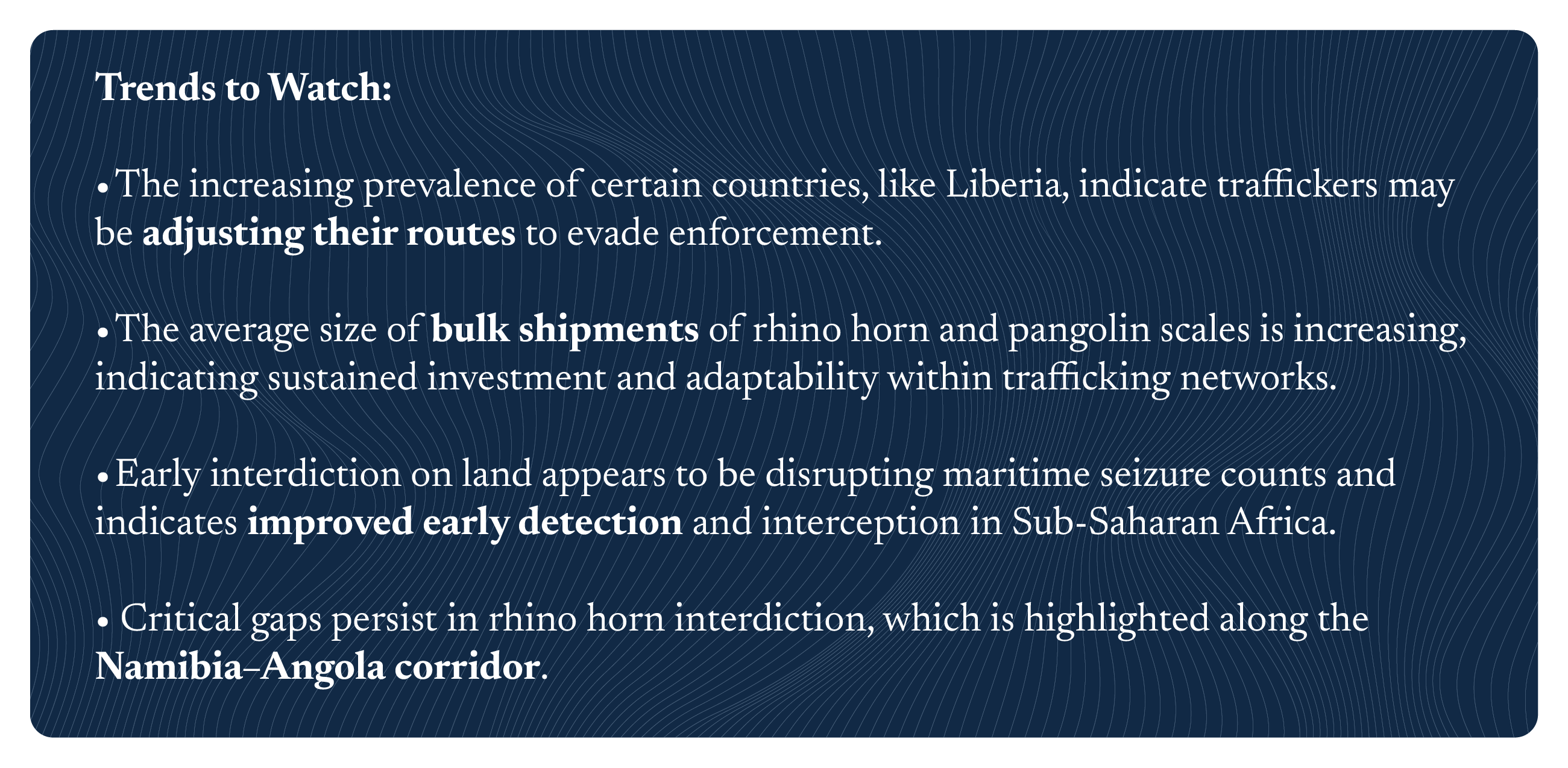
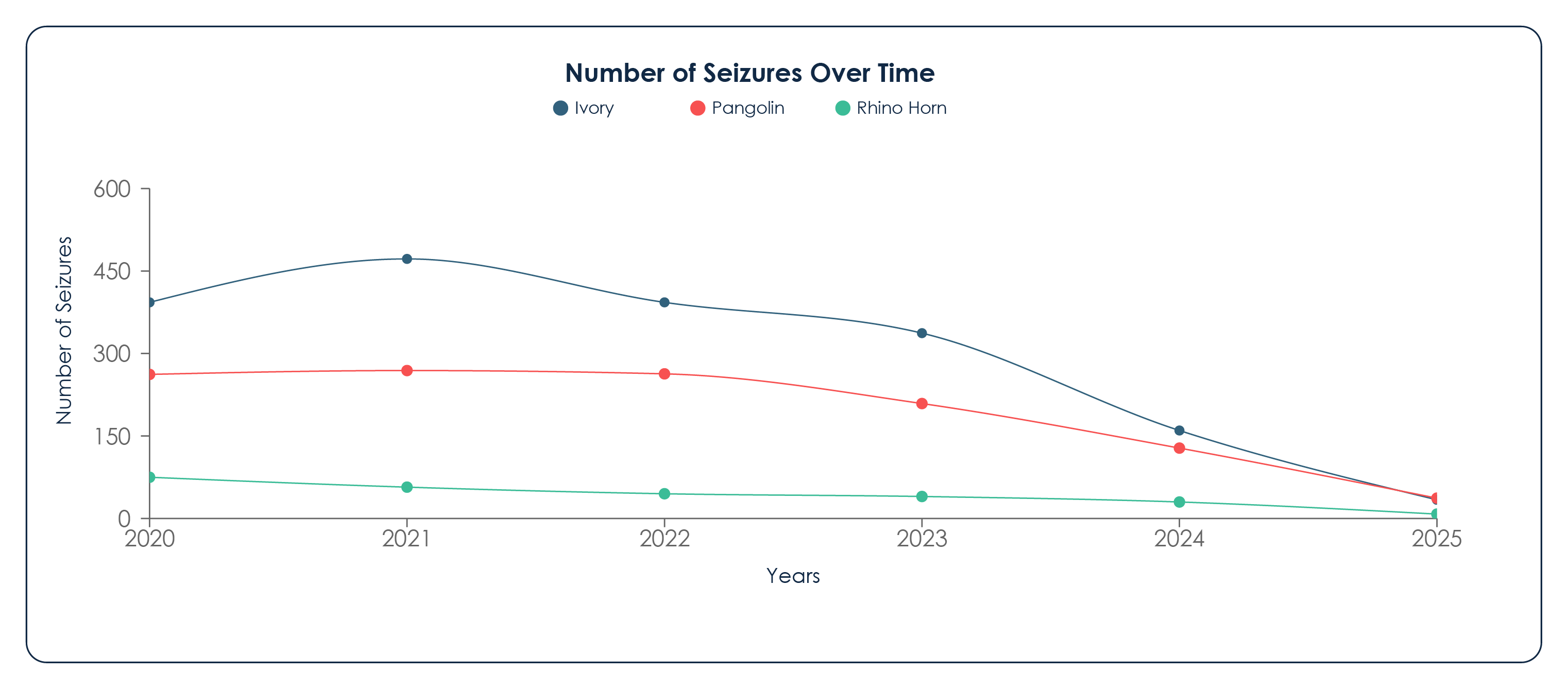
Wildlife trafficking is a sprawling criminal industry worth an estimated USD $8 billion annually and poses a serious threat to environmental, economic, and transnational security. In July 2024, C4ADS released Intercepted, a report analyzing global elephant ivory and rhino horn seizures. Data collected in the 16 months since—including 386 seizures of ivory, rhino horn, and pangolin products—shows that the trends identified in the Intercepted analytical period (2019 through 2023) persist. While the overall number of seizures has declined, indicators such as large-scale bulk shipments, mixed-product trafficking, and volumes of seized rhino horn suggest that trafficking networks remain active and adaptive. Yet, the data also shows evidence of progress for countertrafficking efforts: a proportional decrease in maritime shipments reflecting improved early intervention on the African continent.
As highlighted in Intercepted, bulk seizures indicate complex trafficking network activity, as larger wildlife shipments require logistical expertise and significant up-front investment to sustain operations.[1] Between January 2024 and April 2025, only 4% (16) of global seizures could be classified as bulk seizures.[2] While proportionally small, this fraction accounts for the poaching of an estimated 815 elephants, nine rhinos, and enough pangolins to yield 18 tonnes of scales.[3] While there were fewer bulk seizures in 2024 (14) than in 2022 (26), the average volume of product in bulk pangolin and rhino horn seizures increased.[4] This growth in average bulk shipment size may indicate that traffickers are continuing to offload stockpiled product. Thus, these large seizures are most worthy of additional investigation, analysis, and scrutiny. The largest seizures in the past 16 months included:
IVORY: MARCH 21, 2024, IVO MAPUTO PORT, MOZAMBIQUE
644 ivory pieces weighing approximately 4.8 tonnes were seized from a shipping container in Maputo, Mozambique. The ivory was hidden amidst bags of corn and was enroute to Dubai, UAE with a suspected ultimate destination of Southeast or East Asia.
IVORY: MARCH 17, 2025, IVO LUANDA, ANGOLA
A collection of 1,200 pieces of worked ivory and 31 ivory tusks was seized from a construction site in Camama, Luanda, Angola. Two Vietnamese men were arrested in connection to this trafficking attempt, and seizure data trends analysis indicates that these pieces were likely destined for Vietnam.
RHINO HORN: FEBRUARY 2, 2024, IVO MAPUTO INTERNATIONAL AIRPORT, MOZAMBIQUE
Nineteen rhino horns alongside lion claws and teeth were seized from the luggage of two Vietnamese nationals at Maputo International Airport. Based on the mixed shipment, as well as available data about their travel itinerary, it is likely that they were headed to Vietnam on behalf of a trafficking network.
PANGOLIN: AUGUST 8, 2024, KADUNA, OGUN, AND MUBI, NIGERIA
In an intelligence-led operation, officials conducted seizures from warehouses in Kaduna and Ogun, totaling 2.3 tonnes and 7.2 tonnes of scales, respectively. Later, in December 2024, Nigerian authorities seized another two tonnes of scales from a warehouse in Mubi, Nigeria. Since 2019, Nigeria has been a continental exit point for pangolin and ivory products, particularly through its maritime sector.
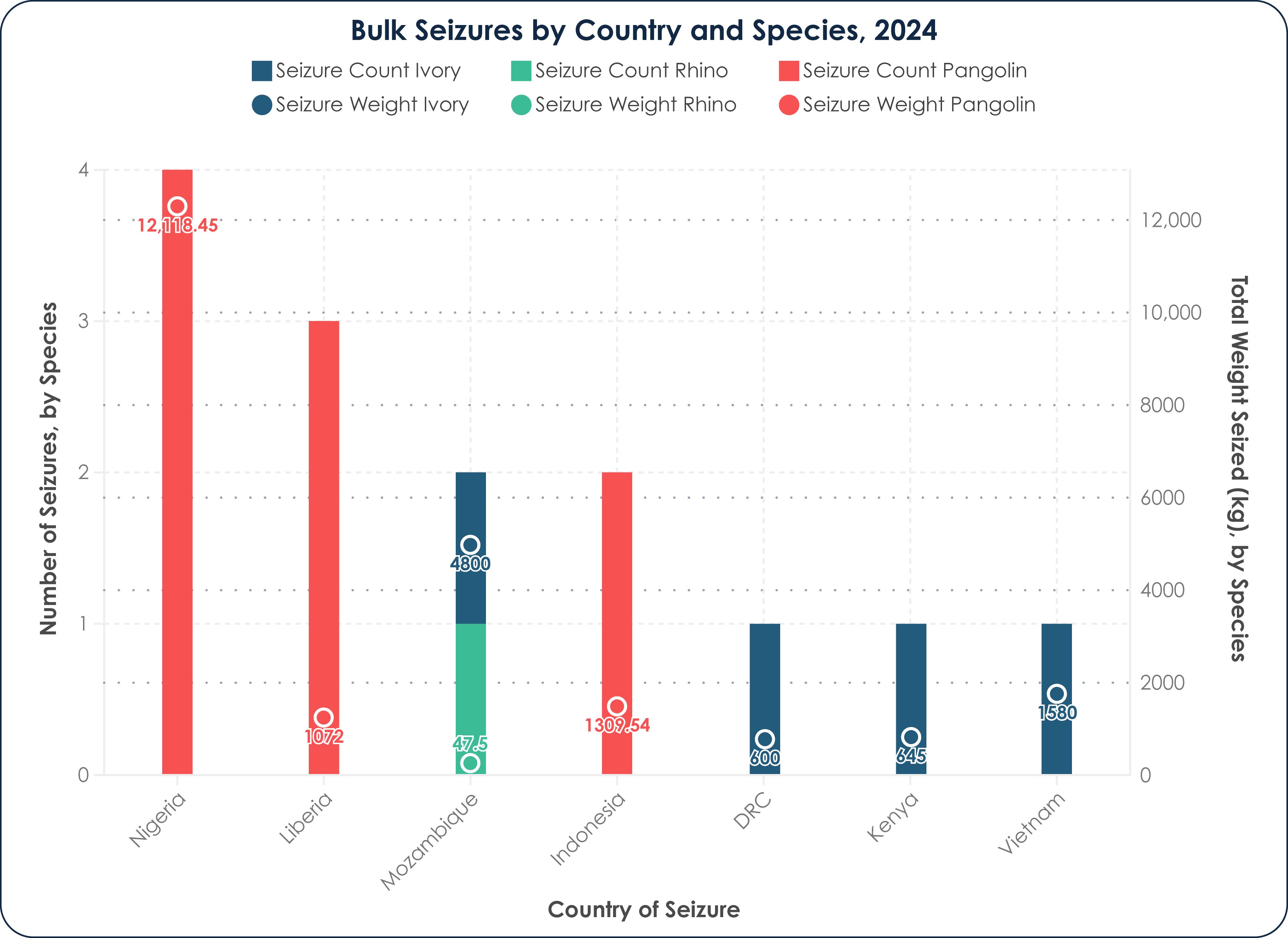
Nigeria experienced the highest number of bulk wildlife seizures in 2024 (four seizures); Liberia experienced the second most (three bulk pangolin scale seizures).[5] Nigeria has been a prominent location for wildlife trafficking, specifically in pangolin products, over the last five years, but as detection, apprehension, and prosecution efforts in Nigeria continue to improve, Nigeria is reportedly becoming a more difficult environment for traffickers to navigate.[6] At the same time, Liberia has seen increasing seizure weights for pangolin scales over the years: two bulk seizures of pangolin scales occurred in the Ivory Coast after departing Liberia in 2022, followed by a 370kg scale seizure in Liberia in 2023, and over one tonne of scales across three seizures in 2024.[7] While these increasing seizure volumes may suggest an increase in trafficking through Liberia, they could also be an indicator of the renewed support that counter-wildlife trafficking programs have been able to deploy in recent years.[8] As law enforcement efforts improve, traffickers are likely to adjust their activity to jurisdictions with lower chances of detection, apprehension, and conviction. Monitoring network adaptation tactics can provide critical insights for interventions that maintain and build pressure against them.
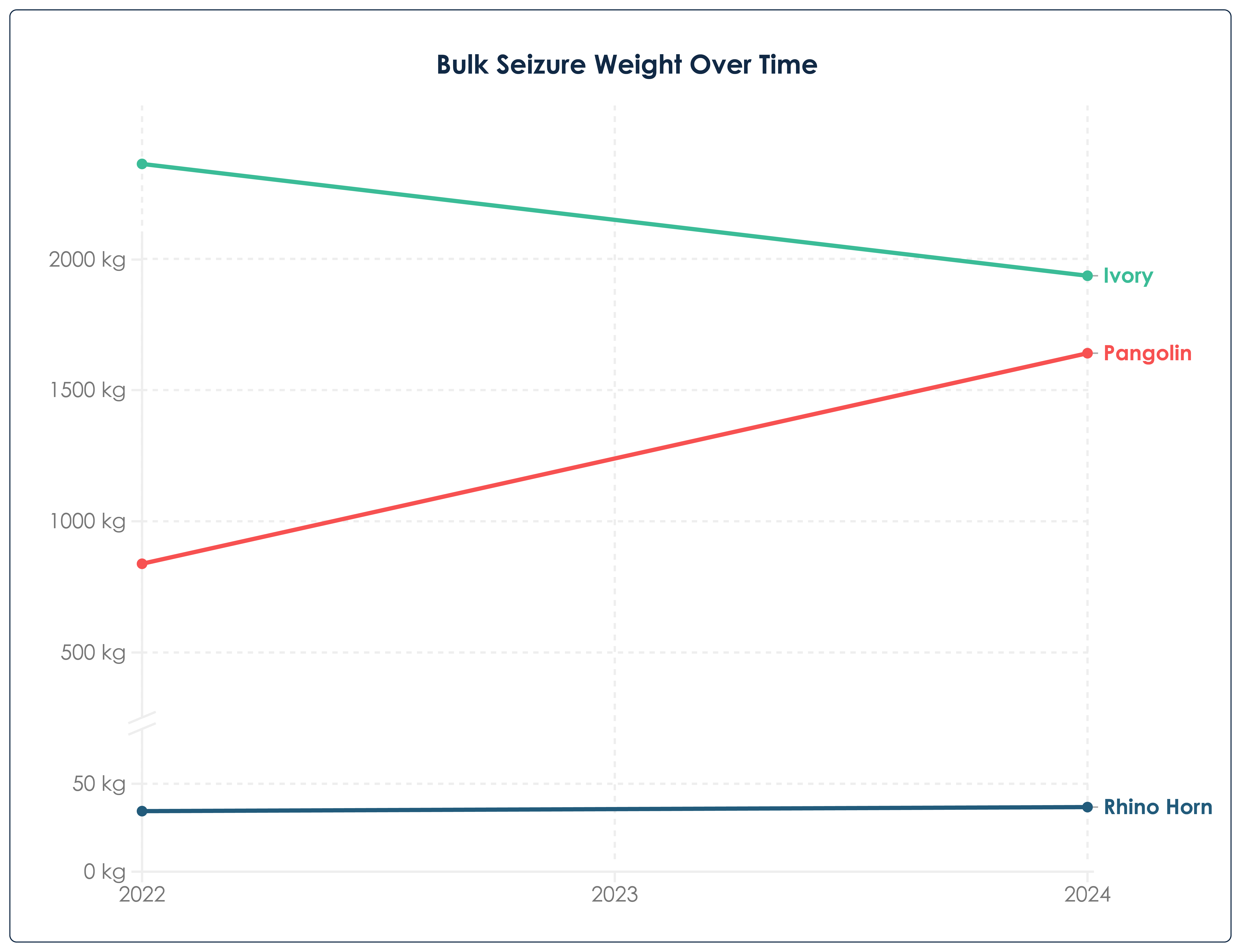
As with bulk seizures, mixed-product seizures often signal the involvement of more sophisticated network operations; they can also signal to investigators how those networks might be changing.[9] In Intercepted, C4ADS found that between 2016 and 2023, mixed ivory and rhino horn shipments typically contained significantly higher volumes of ivory than single-product ivory shipments, while rhino horn volumes remained slightly lower when mixed. Seizure trends from the past 16 months, however, suggest shifting dynamics in rhino-horn trafficking: the recent four weightiest ivory seizures have all contained ivory product alone, while the four weightiest rhino horn seizures were from mixed-product shipments.[10] This may indicate that rhino trafficking networks are diversifying their operations, or conversely, that previously separate networks are expanding into rhino horn trafficking. Mixed shipments of rhino horn from the past 16 months included lion, pangolin, and ivory products.[11]
As wildlife products make their way from the point of collection to the point of dissemination to different consumers, shipment sizes can progressively build up then break down. Throughout a shipment’s journey, traffickers often leverage multiple transport systems to get products to their end destination most efficiently and without detection. For this reason, seizures of smaller shipments and overall transportation methods can give insight into how products are moving along their supply chains. When excluding bulk seizures from analysis, the average seizure size between 2024 and March 2025 by species was: 24kg (elephant ivory); 6kg (rhino horn); and 11kg (pangolin scales).[12] Most of these were apprehended during ground transit, highlighting the continued reliance on overland routes. In contrast, air transit accounted for just 7% of seizures (all weights) in the past 16 months. Historically, air transit was used by traffickers moving product between Africa and Europe or the Americas, yet from 2024-2025 so far, there were no known seizures following these routes.[13]
Maritime seizures, on the other hand, accounted for just 2% of all incidents over the past 16 months, yet they represented a striking 20.7% of the total weight of wildlife products seized. While significant, this percentage is proportionally less than was recorded in 2022 and 2023.[14] Given the ongoing movement of illicit wildlife products between Africa and Asia—and without a corresponding rise in air transit seizures—this decline might initially suggest a drop in enforcement success at seaports. However, this decrease is likely instead driven by improved law enforcement interventions at consolidation points on land prior to maritime containerization export, as was seen with the bulk seizures in Nigeria and Liberia that occurred in warehouse locations.[15]Given the location of those seizures and the quantity of product, it is likely that they would have been transported via maritime shipping lines had they not been seized.

Despite this apparent improvement of early intelligence-led operations in West Africa, interdiction of rhino horn shipments continues to lag behind trafficking activity in Southern Africa. Reportedly, more than 604 rhinos were poached in Sub-Saharan Africa in the past 16 months.[16] Yet during that same period, only 38 rhino horn seizures were publicly reported globally, totaling just 240 kilograms—roughly equivalent to horns from 48 rhinos.[17] In a trend ongoing since Intercepted’s publication, trends in Namibia contribute significantly to this disparity between poaching and seizure numbers. In the past 16 months, at least 81 rhinos have been poached in Namibia, while only eight horns have been seized within the country.[18] This indicates that there were up to 154 rhino horns successfully trafficked out of Namibia. Traffickers are thought to exploit the porous land border between Namibia and Angola to move rhino horns onwards to Asia.[19]
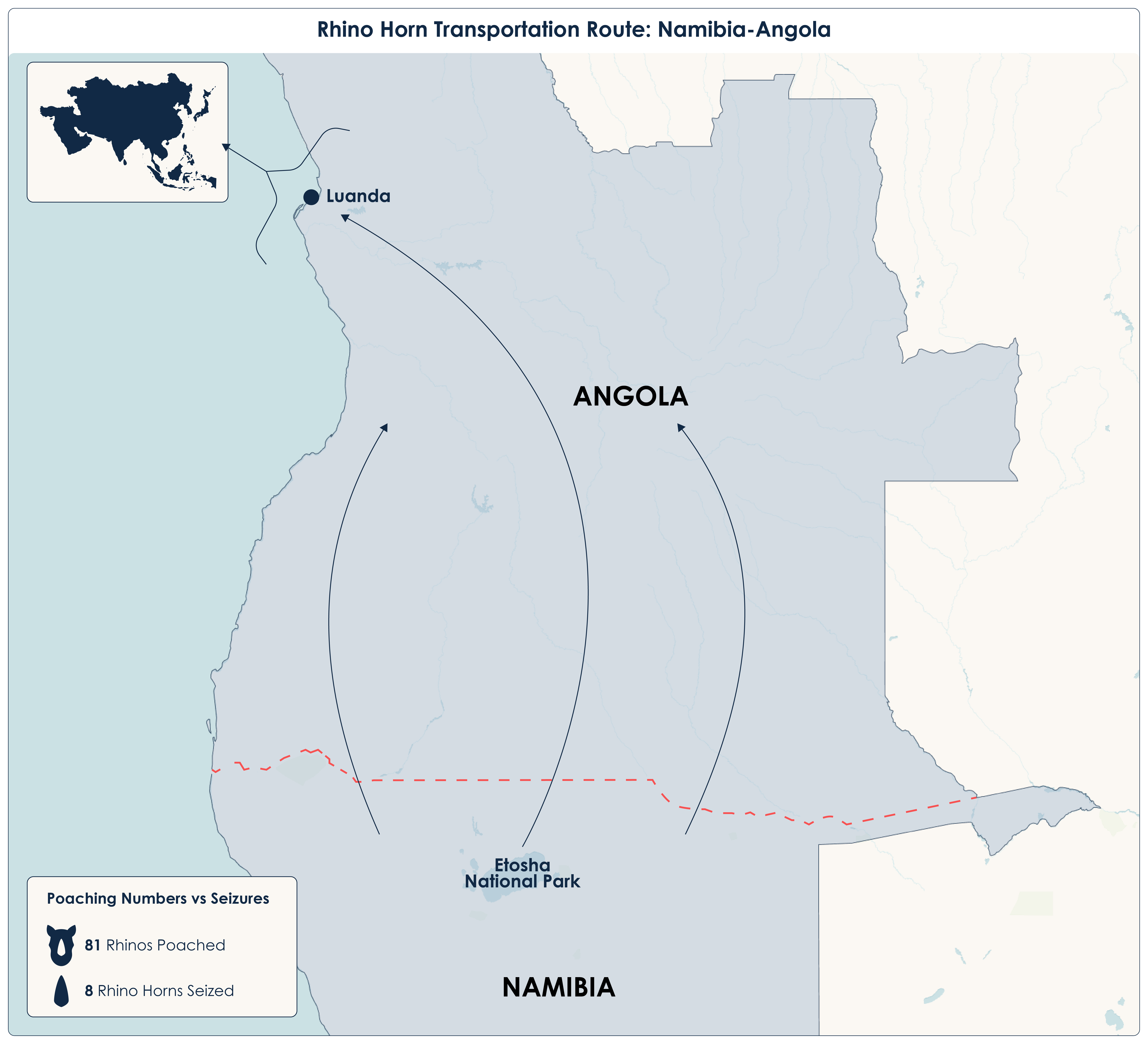
There were zero reported rhino horn seizures in Angola in 2024, indicating that shipments transversing that border have been able to continue onwards. A recent bulk seizure of rhino horn and ivory in Luanda in 2025 indicates that this land route remains a trafficking corridor. Traffickers may take advantage of the complexities of cross-border enforcement collaboration to evade detection by quickly moving poached rhino horns out of Namibia and into Angola for consolidation before transcontinental export.
The past 16 months offer both a roadmap and a reason for cautious optimism as we look ahead in the fight against wildlife trafficking.
- Intelligence driven operations in 2024 and early 2025 led to several high-impact seizures of bulk wildlife products—particularly inland—demonstrating that targeted enforcement can successfully disrupt major trafficking efforts before products depart for other continents.
- These seizures reinforced persistent trends identified in Intercepted, including sustained demand in Asia for elephant ivory, rhino horn, and pangolin scales, as well as traffickers’ continued confidence in their operations.
- Several factors suggest traffickers may be adapting their strategies rather than retreating, including weighty bulk seizures and mixed-product shipments. Yet, adaptation by traffickers is often indicative of successful disruptions that forced them to explore new methods and routes.
As law enforcement and anti-trafficking interventions continue, the goal is to raise the cost and lower the success rate of wildlife crime, ultimately deterring activity of trafficking networks. Success in this fight depends on proactive cross-border collaboration; maintaining vigilance along high-traffic routes; disrupting poaching at its source; and tracking the evolution of both products and perpetrators.
This report was funded in part by a grant from the United States Department of State. The opinions, findings and conclusions stated herein do not necessarily reflect those of the United States Department of State.

[1] Kassa, Saba, Jacopo Costa, and Claudia Baez Camargo, “Corruption and Wildlife Trafficking: Exploring Drivers, Facilitators and Networks Behind Illegal ildlife Trade in East Africa,” Basel Institute on Governance, July 2019, https://baselgovernance.org/sites/default/files/2019-07/WP30_CorruptionandIWT_0.pdf.; “World Wildlife Crime Report,” United Nations Office on Drugs and Crime, United Nations, 2020, www.unodc.org/documents/data-and-analysis/wildlife/2020/World_Wildlife_Report_2020_9July.pdf.
[2] Analytical note: For the purpose of this analysis, bulk seizure is defined as one containing over 500kg of ivory; 25kg of rhino horn; or 100kg of pangolin scales.
[3] C4ADS Wildlife Seizure Database, accessed May 20, 2025.
[4] C4ADS Wildlife Seizure Database, accessed May 20, 2025.
[5] C4ADS Wildlife Seizure Database, accessed May 20, 2025.
[6] Faith Hornor, Noa Tann, Ellen Tyra, “Intercepted,” C4ADS, July, 27 2024, https://c4ads.org/issue-briefs/intercepted/.; Faith Hornor, Amanda Shaver, Devin Thorne, “Tipping the Scales,” C4ADS, September 17, 2020, https://c4ads.org/reports/tipping-the-scales/?utm_source=rss&utm_medium=rss&utm_campaign=tipping-the-scales.; “Joint operation leads to four arrests and major seizure of pangolin scales in Liberia,” Wildlife Justice Commission, July 16, 2024, https://wildlifejustice.org/joint-operation-leads-to-four-arrests-and-major-seizure-of-pangolin-scales-in-liberia/.
[7] Mélèdje Tresore, “Youpougon: 122 kg of Pangolin Scales Seized, 2 Traffickers Arrested,” Fratmat.info, August 15, 2022, https://www.fratmat.info/article/223042/societe/faits-divers/yopougon-122-kg-decailles-de-pangolins-saisis-02-trafiquants-interpelles.; “Guiglo: 2 Traffickers Arrested with 153 kg of Pangolin Scales,” L’info Express, July 9, 2022, https://linfoexpress.com/guiglo-2-trafiquants-mis-aux-arrets-avec-153-kg-decailles-de-pangolins/.; Victoria Wesseh, “Liberia: Man, 47, Arrested for Allegedly Killing Pangolins- Police Reports That Pangolins Scales Are Valued At U.S. $5,535.00,” All Africa, May 30, 2023, https://allafrica.com/stories/202305310111.html.; “Operation pear II: Notorious pangolin scale trafficker arrested in Liberia,” Focused Conservation, July 22,2 2024, https://focusedconservation.org/2024/07/22/operation-pear-ii-notorious-pangolin-scale-trafficker-arrested-in-liberia/.; “Joint Operations,” Wildlife Justice Commission.; “Large Seizure of Pangolin Scales in Liberia,” Focused Conservation, May 5, 2023, https://focusedconservation.org/2023/05/05/large-seizure-of-pangolin-scales-in-liberia/.
[8] “Liberia Special Wildlife Investigation Unit,” Focused Conservation, https://focusedconservation.org/liberia-special-wildlife-investigation-unit/, accessed June 9, 2025.; “Joint Operation,” Focused Conservation.
[9] “Intercepted,” C4ADS.
[10] “Police Among Two Arrested with Elephant Tusks in Nairobi,” The Star, January 16, 2024, https://www.the-star.co.ke/news/realtime/2024-01-16-policeman-among-two-arrested-with-elephant-tusks-in-nairobi.; “Mozambique – Massive Bust Nets 651 Pieces of Elephant Ivory,” ifaw, March 25, 2024, https://www.ifaw.org/international/news/mozambique-massive-bust-elephant-ivory#:~:text=The%20recent%20interception%20of%20a,threat%20to%20global%20conservation%20efforts; “Vietname seizes 1.6 tonnes of smuggled ivory at northern port,” Tuoitre News, April 2, 2024, https://news.tuoitre.vn/vietnam-seizes-16-tonnes-of-smuggled-ivory-at-northern-port-10379125.htm.; “Notorious ivory kingpin nabbed with over 500 kg of elephant tusks,” Mwebantu, April 14, 2025, https://www.mwebantu.com/notorious-ivory-kingpin-nabbed-with-over-500-kg-of-elephant-tusks/.; “Their lives are also lives,” Sohu Government Affairs, March 21, 2024, https://www.sohu.com/a/765862160_121107000.; “ Qatari authorities seize narcotics, bust rhino horn, ivory smuggling,” Doha News, February 3, 2025, https://dohanews.co/qatari-authorities-seize-narcotics-bust-rhino-horn-ivory-smuggling/.; “Luanda: AGT stops departure of more than 500 pieces made of rhino horn and ivory at the airport, which were destined for Vietnam,” Novo Journal, March 20, 2025, https://novojornal.co.ao/sociedade/detalhe/luanda-agt-trava-no-aeroporto-saida-de-mais-de-500-pecas-feitas-de-chifres-de-rinoceronte-e-de-marfim-que-tinham-como-destino-o-vietname-64578.html?fbclid=IwY2xjawJKBH9leHRuA2FlbQIxMQABHZaeJS87VSiSxPdef-emYkMxLMxrFGIePlLJJkApGORIpUMJvvAuD3-rSg_aem_s0TPjvvBeYXVtyQzGc5D3w.; “Mozambique: SERNIC arrests two Vietnamese in possession of rhino horns – Watch,” Club of Mozambique, February 5, 2025, https://clubofmozambique.com/news/mozambique-sernic-arrests-two-vietnamese-in-possession-of-rhino-horns-watch-253488/.
[11] C4ADS Wildlife Seizure Database, accessed May 20, 2025.
[12] Average seizure weight was calculated only using shipments with reported weights in ivory, rhino horn, and pangolin scales. Shipments without reported weight in these categories were not used in calculating average seizure weight.
[13] C4ADS Wildlife Seizure Dashboard, C4ADS, https://wildlifedashboard.c4ads.org/transport_type, accessed May 20, 2025.
[14] C4ADS Wildlife Seizure Database, accessed May 20, 2025.
[15] “Operation Pear II,” Focused Conservation.; “Customs seizes 9,493 kg of Pangolin Scales in landmark wildlife crime bust,” Vanguard, October 18, 2024, https://www.vanguardngr.com/2024/10/customs-seizes-9493-kg-of-pangolin-scales-in-landmark-wildlife-crime-bust/amp/.; “Nine Tons of Illicit Pangolin Scales Recovered in Nigeria,” E360 Digest, October 17, 2024, https://e360.yale.edu/digest/pangolin-scales-nigeria-august.
[16] “Poaching Statistics,” Save The Rhinos, https://www.savetherhino.org/rhino-info/poaching-stats/#:~:text=With%20the%20largest%20rhino%20population,to%20rhinos%20in%20the%20country., accessed June 9, 2025.; “Update on the rhino and elephant poaching situation in Namibia,” Government of Namibia, April 01, 2024, https://www.meft.gov.na/files/files/Poaching%20Update%202024.pdf.; “Rhino Poaching in 2024/ 2025,” Helping Rhinos, https://helpingrhinos.org/rhino-poaching-in-2024/#:~:text=2025%20Update,three%20months%20of%20the%20year., accessed June 9, 2025.
[17] C4ADS Wildlife Seizure Dashboard, accessed May 20, 2025.
[18] Francoise Steynberg, “Rhino Poachers getting Bolder, Farmer Warns,” Namibian Sun, November 20, 2024, https://www.namibiansun.com/environment/rhino-poachers-getting-bolder-farmer-warns2024-11-20.; Francoise Steynberg, “No Bail For ‘Rhino Poachers’ From Gobabis Bull,” Namibian Sun, May 9, 2024, https://www.namibiansun.com/justice/no-bail-for-rhino-poachers-from-gobabis-bull2024-05-09.; Vitalio Angula, “Namibian rhino poaching on rise in first quarter of 2024,” Voa, April 17, 2024, https://www.voanews.com/a/namibia-rhino-poaching-on-rise-in-first-quarter-of-2024/7574124.html.
[19] “Vietnam’s Footprint in Africa,” Environmental investigation Agency, November 2021, https://eia-international.org/wp-content/uploads/EIA-Report-Vietnams-Footprint-in-Africa-Spreads-2021-11.pdf.


